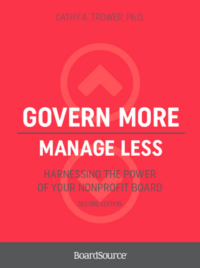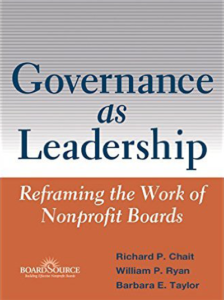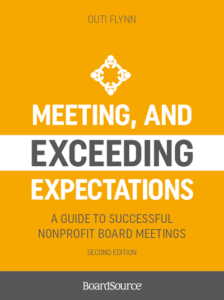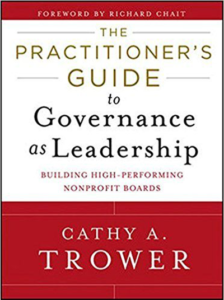Using Generative Governance Principles for Better Boardroom Conversations
For boards looking to take their performance to the next level, generative governance could be the answer. Generative governance provides an opportunity for boards to deepen their analysis and focus on more abstract concepts in order to be more informed decision makers, better able to adapt to a changing environment.
Three Modes
Three key modes, each building on the previous, create a strong foundation for governance.
- Fiduciary Mode: the board is faithful to its mission, accountable for performance, and compliant with relevant laws and regulations. It exercises its legal responsibilities of oversight and stewardship. The board reviews and approves budgets, establishes monetary policies, ensures adequate reserves, and enhances the organization’s reputation by avoiding unnecessary risk and promoting transparency.
- Strategic Mode: the board works with the chief executive and other leaders to set a direction and define the organization’s goals. It is responsible for strategic thinking and direction setting to determine the organization’s priorities and deploy resources accordingly. Board members should be a strategic partner in developing and evaluating the organization’s direction, not simply react to proposals from the chief executive. The strategic mode uses a mental map model to understand and predict the many influences in its internal and external environments.
- Generative: the board’s work entails efforts to make sense of circumstances, discover patterns and discern problems; to make meaning of what’s happening. Along with the chief executive, the board uses generative insight to analyze problems and tackle ambiguous situations, which helps shape the organization’s strategies and decisions. When providing insight and understanding about key issues or questions, generative insight relies on the board having a strong understanding of the organization’s identity so they may tailor solutions to the organization’s goals and values. The third mode depicts the expressive aspects of the organization, where people are concerned not with productivity or logic alone, but also with values, judgments and insights.
If your board has traditionally operated in the fiduciary mode, the strategic mode may be the next step for your organization. Once that has been mastered generative governance can change the way your board operates, and your organization meets its mission and advances its collective purpose.
Generative insight is often the most difficult mindset for boards to master and can require them to step out of their comfort zones. However, combining strong foundations in each of the three mindsets allows the board to achieve a higher level of leadership and governance.
Adopting the third mindset
Board members may be so comfortable with fiduciary oversight that they may struggle to grasp the concepts inherent to generative insight. A few tactics can help board members adopt a new mode of governance:
- Clearly define generative insight. If board members don’t fully understand what generative insight is, how will they be able to put it into practice? Encourage discussions about what generative governance is, how it can impact the board and organization, and why board members may be struggling to understand or embrace the change.
- Practice all three types of governance. Being able to define and consciously think in each of the three mindsets will help board members identify what distinguishes generative governance and how they need to change their ways of approaching conversations. Not every decision lends itself to all three modes, many fit squarely in one or the others. Occasionally there are decisions that can be considered in each and all.
- Recognize that using all three mindsets takes time. Introducing generative governance to a board will not happen overnight. It takes a commitment from all board members, an understanding of what generative insight is and how to use it in the boardroom, and practice. The board chair and chief executive must ensure board members do not get frustrated, instead opening up discussion about specific challenges and inviting questions and comments.
Once you start, generative governance is an opportunity to consider when the board comes into a discussion and how they, in partnership with the chief executive, can view a variety of situations and decisions.
FOUNDATION OF GENERATIVE GOVERNANCE
In order to embrace a new mode of governance, board members must be prepared to engage on a different level than they did previously. Generative governance requires board members to analyze and discuss issues from a macro lens. This requires preparing for board meetings and asking different — and better — questions. Instead of focusing on the immediate, short-term considerations — such as whether or not the budget is balanced — the board should think deeper, instead asking about whether the budget reflects organizational priorities, aligns with its values and advances its mission and collective purpose.
Restructuring Board Meetings
One major piece of the board’s operating procedures that will likely need to change when transitioning to a generative mode of governance is the way board meetings are structured. Board members must feel that they have the time and resources for critical thinking and debate.
Meeting Agenda
The organization’s chief executive and board chair should work together on the meeting agenda to ensure enough time is built in for board members to thoroughly discuss and analyze critical issues. Additionally, the most important issues should be discussed first and any related items should be placed together in case information from one item informs the other.
When first introducing generative governance, the chief executive and the board chair may struggle with formulating the right questions to encourage generative discussions. Starting with catalytic questions can help, but beyond that, questions should be open-ended, focus on long-term considerations, and relate to the organization’s mission and goals. Restructuring meetings to emphasize generative governance requires a strong partnership between the chief executive and board chair, especially as it relates to stimulating discussion and encouraging the board to think critically.
Pre-reading
When board members have not adequately prepared for meetings, too much time is spent reviewing documents and getting everyone up to speed. If the board is planning to discuss a newly proposed project or an issue impacting the community the organization serves, all board members should be given pre-reading well in advance of the board meeting to ensure they have time to digest the necessary information and come to the table prepared to share their opinions. Pre-reading also allows reports to be approved as a collective in a consent agenda.
Consent Agenda
Many boards spend the majority of their meetings reviewing reports, leaving little time for critical thinking. Reducing the amount of time spent reviewing things that have already happened and using a consent agenda to approve reports that do not require a presentation, discussion or deliberation allows for more time for discussion of bigger-picture issues. Any board member can remove a report from the consent agenda should they wish it to be discussed and deliberated.
Board Recruitment
Enhanced board recruitment is one way to shift away from solely focusing on fundraising and oversight and embrace all of the opportunities for exceptional board governance, including generative governance. It allows your board to move toward becoming a Purpose-Driven Board.
Diversity on boards is an important component of critical thinking — not just racial, ethnic, or gender diversity, but diversity of experience, thinking styles and problem-solving. Equity in recruitment and the creation and maintenance of an inclusive culture ensures that everyone’s voice is heard, appreciated and valued. Encouraging new ways of analyzing ideas and approaching big-picture questions helps deepen discussion.
Purpose-driven boards make sense of the circumstances causing the need for their organization, are aware of the collective purpose that their organization exists to advance, and are intentional about recruiting and embracing the community they serve.
MOVE PAST TRADITIONAL BARRIERS TO CRITICAL THINKING
Certain problems that plague many board meeting discussions can be especially problematic for boards practicing generative governance. To encourage robust discussion, all board members must feel comfortable speaking their minds, but must also question assumptions, decisions, and conclusions — even their own! — to ensure common deliberation issues do not impact boardroom discussions. Identifying barriers to critical thinking is the first step toward promoting generative conversations. The next is to take steps to minimize the effect of many of these impediments.
![]() Barrier: Fear of being wrong or changing one’s opinion due to group consensus.
Barrier: Fear of being wrong or changing one’s opinion due to group consensus.
Approach to mitigating: Encourage board members to ask questions instead of making statements. During deliberation, break the board up into smaller groups and ask each to discuss different solutions.
![]() Barrier: Clarifying the difference between a “gut feeling” and information that a board member knows to be correct because of supporting data or testing.
Barrier: Clarifying the difference between a “gut feeling” and information that a board member knows to be correct because of supporting data or testing.
Approach to mitigating: Ask board members to challenge the genesis of the information. Approaching a question from a different perspective could shed light on incorrect assumptions.
![]() Barrier: Wedding oneself to an initial assumption or conclusion or assuming everyone in the room agrees on a solution.
Barrier: Wedding oneself to an initial assumption or conclusion or assuming everyone in the room agrees on a solution.
Approach to mitigating: Before discussing an issue, have board members write down the most important question they think should be considered. After doing so, anonymously read the responses and tally all similar questions.
![]() Barrier: Assuming board members always make rational decisions.
Barrier: Assuming board members always make rational decisions.
Approach to mitigating: Think about how decisions are made instead of the final conclusion. Consciously frame discussions. Labeling something as an opportunity rather than a problem can influence how it is discussed and perceived. Continually question how an issue is framed, even during deliberation.
CRITICAL ITEMS FOR CHIEF EXECUTIVES
It’s not just the board that will be impacted by a new governance model. An organization’s chief executive must also be prepared for a change in boardroom dynamics. There are six critical things that effective chief executives must be able to do:
- Ensure that nothing is ‘undiscussable’ in the boardroom.
- Not think they have all the right answers or even all the right questions.
- Invite dissent.
- Share information, power, and leadership opportunities.
- Not shy away from questions from the board- understand governance is a partnership.
- Not be completely wedded to the past or too far out in front on the board.
Generative governance is not a one-size-fits-all solution. The board and organizational leaders must mutually decide to adopt a governance as leadership model and then identify the best way to move forward.
Successfully adopting a generative governance model lead to higher-level thinking, more engaging and effective board meetings, and a stronger organization.
HELPFUL RESOURCES
101 Resource | Last updated: April 22, 2024



